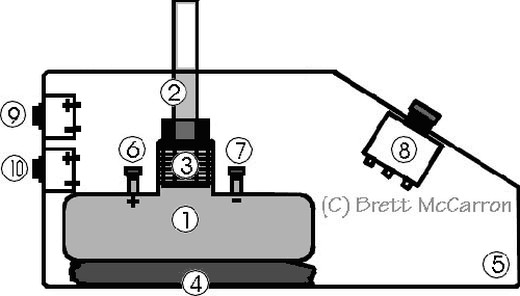The talk box is not to be confused with other effects devices, such as the wah-wah pedal or vocoder. A wah-wah pedal is another staple of classic rock music, but musicians simply use a foot pedal to make an electric guitar’s frequency shift from treble to bass, creating a “wah” sound.” And a vocoder is a device that filters and processes a human voice, and spits it out again sounding computerized and robotic. Some also mistake the talk box for Auto-Tune, a technique that has become popular in the past few years, especially in pop music. Auto-Tune is a type of software that can help slightly manipulate a singer’s voice to hit the right notes.
The talk box device, on the other hand, takes advantage of the unique qualities of the human mouth and vocal tract and lends them to instruments.
Talk Box Mechanics
The talk box is a surprisingly simple device, but in order to understand how it works, we’ll have to appreciate some of the complexities of the human vocal tract. We push air from our lungs through our vocal folds (also called vocal cords) in the larynx. The vocal folds are the things that create an air valve and allow us to vibrate the air, which makes our speech audible. The larynx muscles also control pitch and tone. But it’s the mouth, with its tongue, palate, teeth and lips, that helps us form different sounds to create words and complex language.
An instrument, like a guitar, doesn’t have lungs to power its sound. Rather, the musician plucks or strums its strings to cause vibrations, which in turn form the sound. What the talk box does is allow the musician to lend his or her mouth to the instrument as well.
To help explain how this is possible, let’s go over the mechanics. A talk box, in its simplest form, consists of a horn driver and a plastic tube. You’ll even find tutorials on the Internet that can teach you how to make a crude version at home with some materials from the hardware store. A commercial talk box, however, will provide the best sound.
The commercial version will be a small effects box with an input, an output and a long plastic tube. To get the best effect, the setup should include an amplifier and a PA system. The plastic tube, which is connected to the effects box, can be affixed to a microphone stand by clipping or taping it up to the stand and the microphone itself. It’s usually arranged so that the the tube is just long enough to let the last several inches protrude from the mic. The guitar should be connected to the amplifier, which in turn connects to the talk box input. The speaker system can then connect to the talk box output.
The guitarist then places the end of the plastic tube halfway into his or her mouth. Thus, the amplified guitar sound is driven directly into the mouth. The mouth’s voicings and movements can then actually manipulate and shape the guitar notes and chords. It can be tricky to master, however. If you’re trying this at home for the first time, experts recommend starting with “ah,” “oh” and “eee” sounds.
For more Detail: How Talk Boxes Work

